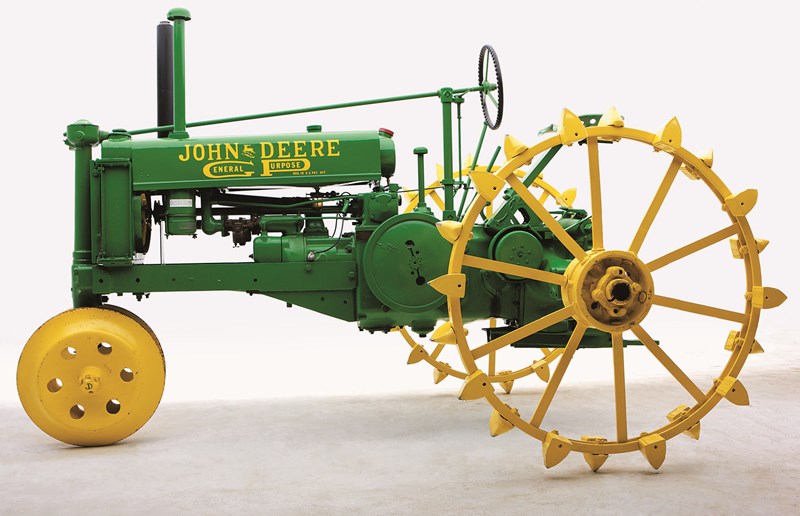The John Deere B, an enduring symbol of agricultural prowess and innovation, holds a hallowed place in the annals of farming history. Produced from 1935 to 1938 as part of the Two-Cylinder Letter Series, this row-crop tractor emerged from the heartland of Waterloo, Iowa, USA. Its remarkable legacy can be divided into three distinct phases: the original “unstyled” B, the “early styled” model B introduced in 1939, and the “late styled” iteration from mid-1947. With its variations catering to diverse farming needs, from orchards to wide row-crop applications, the John Deere B represents a transformative period in American agriculture, showcasing power, durability, and timeless design.
| John Deere B (1935-1938) Specs |
|---|
| Model Year | 1935-1938 |
| Series | Two-Cylinder Letter Series |
| Type | Row-Crop Tractor |
| Production |
|---|
| Manufacturer | John Deere |
| Total Built | 55,670 (all unstyled) |
| Variants |
|---|
| B | Tricycle Front Axle |
| BR | Fixed Front Axle |
| BO | Orchard |
| BN | Narrow Row-Crop |
| BW | Wide Row-Crop |
| BI | Industrial Tractor |
| BO Lindeman | Crawler |
| Engine Detail |
|---|
| Type | John Deere, All Fuel |
| Configuration | 2-Cylinder, Liquid-Cooled |
| Displacement | 149 cubic inches (2.4 L) |
| Bore/Stroke | 4.25×5.25 inches (108 x 133 mm) |
| Fuel System | Marvel-Schebler DLTX-10 Carburetor |
| Cooling System | Thermo-Siphon |
| Air Cleaner | Oil Bath |
| Compression Ratio | 4.71:1 |
| Rated RPM | 975 |
| Firing Order | 1-2 |
| Starter Type | Hand-Crank (Electric Starter Optional) |
| Oil Capacity | 7 quarts (6.6 L) |
| Coolant Capacity | 22 quarts (20.8 L) |
| Sparkplug Gap | 0.030 inches (0.762 mm) |
| Point Gap | 0.015 inches (0.381 mm) |
| Intake Valve Clearance | 0.020 inches (0.508 mm) |
| Exhaust Valve Clearance | 0.020 inches (0.508 mm) |
| Transmission |
|---|
| Manufacturer | John Deere |
| Type | Unsynchronized Gear |
| Gears | 4 Forward and 1 Reverse |
| Clutch | Dry Disc |
| Power |
|---|
| Drawbar (Claimed) | 12 hp (8.9 kW) |
| Belt (Claimed) | 16 hp (11.9 kW) |
| Plows | 2 (10-inch) |
| Drawbar (Tested) | 11.80 hp (8.8 kW) |
| Belt (Tested) | 16.01 hp (11.9 kW) |
| Mechanical |
|---|
| Drive | Two-Wheel Drive |
| Steering | Manual |
| Brakes | Differential Mechanical Expanding Shoe Brakes |
| Operator Station | Open with Pressed Steel Seat |
| Power Take-off (PTO) |
|---|
| Rear PTO Type | Transmission-Driven |
| Rear PTO RPM | 540 |
| Serial Numbers |
|---|
| 1935 | 1000 |
| 1936 | 12012 |
| 1937 | 27389 |
| 1938 | 46175 (also noted as *49302) |
| 1939 | 60000 |
| 1940 | 78526 |
| 1941 | 96000 |
| 1942 | 118721 |
| 1943 | 136315 |
| 1944 | 149219 |
| 1945 | 167700 |
| 1946 | 179788 |
| 1947 | 191303 |
| 1948 | 209295 |
| 1949 | 230044 |
| 1950 | 253025 |
| 1951 | 275242 |
| 1952 | 293030 |
| Final | 310772 |
| Belt Pulley |
|---|
| Diameter | 9.6875 inches (24 cm) |
| Width | 7.25 inches (18 cm) |
| RPM | 1250 |
| Speed | 3110 ft/min (947.93 meters/min) |
| Tires |
|---|
| Ag Front | 22×3.25 (Steel) |
| Ag Rear | 48×5.25 (Steel) |
| Dimensions |
|---|
| Length | 120.5 inches (306 cm) |
| Width | 85 inches (215 cm) |
| Height (Hood) | 56 inches (142 cm) |
| Weight | 3,275 lbs (1485 kg) |
| Rear Tread | 56 to 84 inches (142 to 213 cm) |
John Deere B overview
The John Deere B, an iconic collection model with immense historical value, stands as a testament to American farming heritage and innovation. This revered tractor boasts a unique legacy, represented by three distinct phases.
The John Deere B from 1935 to 1938, often referred to as the “unstyled” version, marked its entry into the farming world as a compact yet robust row-crop tractor. With a hand-crank starter and a simple yet effective design, it became a reliable workhorse for many farmers during the Great Depression. Its streamlined look and durable construction are a hallmark of this era.
In 1939, the “early styled” John Deere B made its debut, signifying a new era of design and functionality. With improved aesthetics, an electric starter, and refinements to the engine, this model catered to evolving farm needs. It bridged the gap between the vintage charm of the unstyled B and the modernity of the later iterations.
The “late styled” John Deere B, produced from 1947 to 1952, brought further advancements to the table. Featuring a pressurized cooling system with a steel radiator and improved front-end design, it offered enhanced performance and durability. The addition of options like the Roll-o-Matic front end and electric starting and lighting made it a versatile choice for farmers.
Comparing these models, the 1935-1938 version, with its unstyled simplicity, represents the roots of the John Deere B legacy. The 1939-1946 “early styled” model bridges the gap between vintage and modern, while the 1947-1952 “late styled” variant showcases the pinnacle of technological advancements in its time. Each model has its unique charm and historical significance, making the John Deere B a captivating collector’s item that embodies the evolution of American agriculture.
